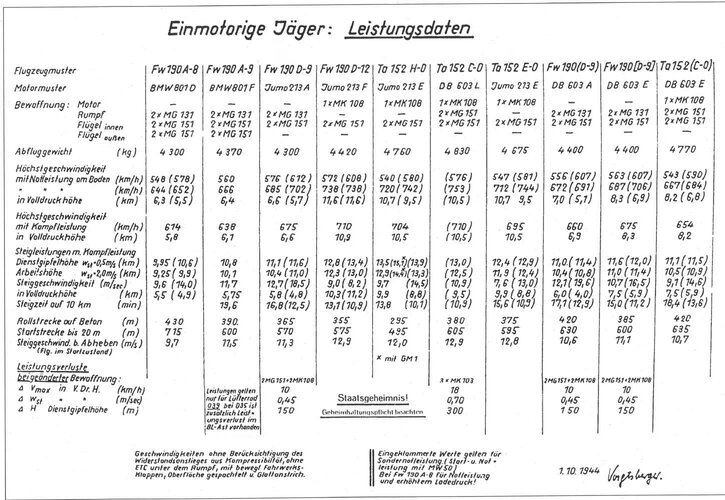Hi Tomo,
It maybe was not a wonder, but it was a low-drag aircraft when compared with other fighters powered by radial engines, or the Doras when compared with V12-powered fighters. Being small, with fully retractable and covered U/C, as well as the well slanted windscreen = all played the part in shedding the drag to the realistic minimum.
Hm, the Doras and their drag are a bit enigmatic, but my impression is that they weren't all that much better than the Antons. And accordingly, overall the Me 109 made more speed at the same horsepower, though the Dora was fast because it had more power available (except when comparing special emergency power, perhaps).
The guns might need a reassessment.
Eg. the LMGs barely contributed to firepower once the 2, let alone 4 cannons were carried, while adding to drag (not by much). The ammo drum cover for the MG FFM cost some speed. The cowl HMGs were probably the worst - barely making a dent on the aircraft of 1944, yet cost 10+- km/h; the 3 cannon installation on D-12
was less draggy than 2 cannon + 2 HMG on D-9, even though the 30mm was the central cannon. The wing root MG 151/20s will add drag vs. MG 17s in the same space.
I really wonder why the MGs were kept at all. They might have been desired for strafing, but I'm really puzzled why they weren't made a removable Rüstsatz or something. Two wing-root cannon were plenty of firepower, in a great arrangement close to the centreline ... one shouldn't have needed MGs to go with that, at least not considering the price in drag and weight paid for carrying them. In a time when German engines were behind the curve, eliminating inefficient equipment should have been high on the list of priorities.
A DB-601E/605A powered Fw 190 will do a lot of work even with just 3 MG 151s (or the MG 151/20s combined with MK 108), while not being any slower than a Bf 109F/G with cannons in gondolas.
Well, I believe the MK108 arrived at the scene very late, so you might not want to risk an underpowered aircraft against superior numbers of superior performing Allied fighters. The gondolas were mostly removed from the Messerschmitts too, I believe.
Maybe the Fw 190B would have been a better basis for a DB605A-powered Focke-Wulf, having shed quite a bit of extra weight in the attempt to achieve high-altitude performance.
Those were supposed to be armed with just 2 cannons, and also lacking protection for fuel tanks?
Hermann's book on the Fw 190 Höhenjäger with regard to the Fw 190B states: According to the production planning document dating December 1941, it was scheduled for mass production, starting in June 1942, in parallel to the Fw 190A, for a total of 2991 aircraft until September 1943. Anton output in the same period was to be 1052 aircraft, so the Bertha would have been the primary type.
The Fw 190B-1 was planned to be equipped with:
Enlargend wing of 20.3 m^2 area and 12.3 m span.
External ram-air engine intakes
Pressure cabin - not initially, later to be introduced into the series, 45 kg extra weight
Unprotected fuel tanks for 525 L C3 fuel
Armour - 48 kg engine armour, 16 kg armour glass windscreen. No back armour.
2 MG151 wing root guns
FuG 16 Z
no MG 17 cowl guns
no MG FF wing guns as Rüstsatz
no bomb Rüstsätze installed
apparently, no GM-1 system as it's not listed in the Baubeschreibung
The tank question is a bit puzzling as the capacity is the same as that of the protected tanks. As the "Behälterschutz" (tank protection) is listed under armour, with 50.5 kg, I'm not sure this means the tanks were not self-sealing ... this sounds almost as if the Anton had belly plates normally protecting the fuel tanks. I thought this was a Jabo-specific modification, but I don't really know at the moment. On the other hand, this table lists 20 kg extra fuel, which would come down to about 30 L extra capacity.
The problem with Hermann's book is, it's an editorial mess. On the pages supposed to show the Baubeschreibung from 14 August 1941, there's a data sheet with performance curves dated 28 November 1942 - that really makes me wonder, what else did Hermann mix together? There are certain internal contradiction in the Baubeschreibung chapter, and more controdictions to the chapter about the scheduled series production.
The projected top speed for a fighter apparently equivalent to the by-then canceled Fw 190B-1 in the November 1942 graph is 690 km/h @ 7 km, using take-off/emergency power of the BMW 801D. Using this aircraft as a basis, but increasing weight to 4106 kg like the A-5, and reducing ram efficiency to match the internal intakes on the A-5, I calculate a top speed of 672 km/h vs. the 656 km/h from the data sheet, so the combined effect of the drag reduction from removing nose and outer wing guns and the drag increase from the larger wing was worth 16 km/h speed increase.
There's another performance diagram on page 24, but it's so closely cropped that all the important information necessary for understanding the diagram is missing. That's why I hate Hermann's books ... great sources prevented in a way that makes them close to useless.
The Fw 190B-1 re-engined to the DB605A (and lightened by another 200 kg to account for the lighter engine) would be sort of comparable to the Me 109G using the same engine, I presume. However, Me 109G performance really is a can of worms all of its own (and the Me 109 did have rear armour, so the comparison isn't entirely fair.)
Regards,
Henning (HoHun)


